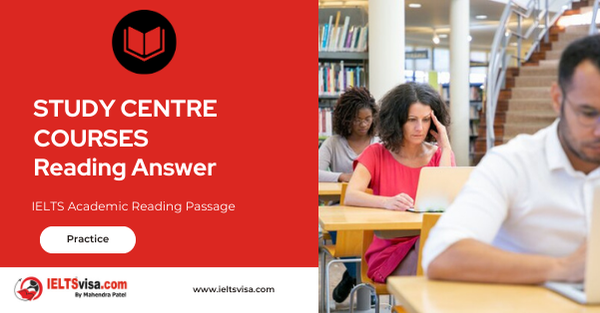Locked Doors Open Access Reading Answers
IELTS Academic Reading Passage
The word, ‘security’, has both positive and negative connotations. Most of us would say that we crave security for all its positive virtues, both physical and psychological – its evocation of the safety of home, of undying love, or of freedom from need. More negatively, the word nowadays conjures up images of that huge industry which has developed to protect individuals and property from invasion by ‘outsiders’, ostensibly malicious and intent on theft or wilful damage.
Increasingly, because they are situated in urban areas of escalating crime, those buildings which used to allow free access to employees and other users (buildings such as offices, schools, colleges or hospitals) now do not. Entry areas which in another age were called ‘Reception’ are now manned by security staff. Receptionists, whose task it was to receive visitors and to make them welcome before passing them on to the person they had come to see, have been replaced by those whose task it is to bar entry to the unauthorized, the unwanted or the plain unappealing.
Inside, these buildings are divided into ‘secure zones’ which often have all the trappings of combination locks and burglar alarms. These devices bar entry to the uninitiated, hinder circulation, and create parameters of time and space for user access. Within the spaces created by these zones, individual rooms are themselves under lock and key, which is a particular problem when it means that working space becomes compartmentalized.
To combat the consequent difficulty of access to people at a physical level, we have now developed technological access. Computers sit on every desk and are linked to one another, and in many cases to an external universe of other computers, so that messages can be passed to and fro. Here too security plays a part, since we must not be allowed access to messages destined for others. And so the password was invented. Now correspondence between individuals goes from desk to desk and cannot be accessed by colleagues. Library catalogues can be searched from one’s desk. Papers can be delivered to, and received from, other people at the press of a button.
And yet it seems that, just as work is isolating individuals more and more, organizations are recognizing the advantages of ‘team-work’; perhaps in order to encourage employees to talk to one another again. Yet, how can groups work in teams if the possibilities for communication are reduced? How can they work together if e-mail provides a convenient electronic shield behind which the blurring of public and private can be exploited by the less scrupulous? If voice-mail walls up messages behind a password? If I can’t leave a message on my colleague’s desk because his office is locked?
Team-work conceals the fact that another kind of security, ‘job security’, is almost always not on offer. Just as organizations now recognize three kinds of physical resources: those they buy, those they lease long-term and those they rent short-term – so it is with their human resources. Some employees have permanent contracts, some have short-term contracts, and some are regarded simply as casual labour.
Telecommunication systems offer us the direct line, which means that individuals can be contacted without the caller having to talk to anyone else. Voice-mail and the answer-phone mean that individuals can communicate without ever actually talking to one another. If we are unfortunate enough to contact organizations with sophisticated touch-tone systems, we can buy things and pay for them without ever speaking to a human being.
To combat this closing in on ourselves we have the Internet, which opens out communication channels more widely than anyone could possibly want or need. An individual’s electronic presence on the Internet is known as a ‘Home Page’ – suggesting the safety and security of an electronic hearth. An elaborate system of 3-dimensional graphics distinguishes this very 2-dimensional medium of ‘web sites’. The nomenclature itself creates the illusion of a geographical entity, that the person sitting before the computer is travelling, when in fact the ‘site’ is coming to him. ‘Addresses’ of one kind or another move to the individual, rather than the individual moving between them, now that location is no longer geographical.
An example of this is the mobile phone. I am now not available either at home or at work, but wherever I take my mobile phone. Yet, even now, we cannot escape the security of wanting to ‘locate’ the person at the other end. It is no coincidence that almost everyone we see answering or initiating a mobile phone-call in public begins by saying where he or she is.
Questions 15-18
Choose the correct answers A-D and write them next to 15-18 on your answer sheet
15 According to the author, one thing we long for is
A the safety of the home
B security
C open access
D positive virtues
16 Access to many buildings
Ais unauthorized
B is becoming more difficult
C is a cause of crime in many urban areas
D used to be called ‘Reception’
17 Buildings used to permit access to any users
A but now they do not
B and still do now
C especially offices and schools
D especially in urban areas
18 Secure zones
A do not allow access to the user
B compartmentalize the user
C are often like traps
D are not accessible to everybody
Questions 19-24
Complete the summary below using words from the box.
Write your answers in the blank spaces next to 19-24 on your answer sheet
The problem of physical access to buildings has now been 19………………………………by technology. Messages are 20………………………………with passwords not allowing 21…………………………to read someone else’s messages. But, while individuals are becoming increasingly 22……………………………..socially by the way, they do their job, at the same time more value is being put on 23…………………………………. However, e-mail and voice-mail have led to 24…………………………………opportunities for person-to-person communication.
|
Reducing off |
Computer |
Other people |
Isolating |
|
Teamwork |
Decrease in |
Similar |
Solved |
|
No different from |
Overcame |
Physical |
Protected |
|
Combat |
Developed |
Cut-off |
|
Questions 25-27
Complete the sentences below, with words taken from Reading Passage 2.
Use NO MORE THAN THREE WORDS for each answer.
Write your answers in the blank spaces next to 25-27 on your answer sheet
25 The writer does not like……………………………….
26 An individual’s Home Page indicates their………………………………on the Internet.
27 Devices like mobile phones mean that location is…………………………..

Solution For: Locked Doors Open Access
Reading Answers
| 15. B | 22. cut-off |
| 16. B | 23. team-work |
| 17. A | 24. decrease in |
| 18. D | 25. touch-tone systems |
| 19. solved | 26. electronic presence |
| 20. computers | 27. no longer geographical |
| 21. other people |
Review and Practice
- Regularly practice with IELTS reading samples and time yourself to get used to the pressure of the exam.
- Review your mistakes to understand where you went wrong and how to avoid similar errors in the future.
Our Books
Master IELTS Speaking Part 1
IELTS Writing Task 1 Book
IELTS Writing Task 2 Book
Locked Doors Open Access Reading Answers Explanation
Comin Soon
Practice IELTS Other Modules
IELTS Listening
The IELTS Listening test assesses how well you can understand spoken English in various contexts. It lasts about 30 minutes and is divided into four sections with a total of 40 questions. The listening tasks become increasingly difficult as the test progresses.
IELTS Academic Reading
The IELTS Academic Reading section assesses your ability to understand and interpret a variety of texts in academic settings. It is designed to evaluate a range of reading skills, including skimming for gist, reading for main ideas, reading for detail, understanding inferences, and recognizing a writer's opinions and arguments.
IELTS Speaking
The IELTS Speaking test assesses your ability to communicate in English on everyday topics. It lasts 11-14 minutes and consists of three parts: introduction, cue card, and a discussion based on the cue card topic.
IELTS General Reading
IELTS General Reading tests your ability to understand and interpret various types of texts. Here are some key areas and types of content you can expect to encounter in the reading section, along with tips for effective preparation.
IELTS Academic Writing Task 1
In IELTS Academic Writing Task 1, you are presented with a visual representation of information, such as graphs, charts, tables, or diagrams, and you are required to summarize, compare, or explain the data in your own words.
IELTS General Writing Task 1
In IELTS General Writing Task 1, you are required to write a letter based on a given situation. The letter can be formal, semi-formal, or informal, depending on the prompt. Here’s a breakdown of the key components to include in your letter
IELTS Academic Writing Task 2
In IELTS Academic Writing Task 2, you are required to write an essay in response to a question or topic. Here’s a guide to help you understand the essential elements of this task
IELTS Exam Tips
To succeed in the IELTS exam, practice regularly, familiarize yourself with the test format, improve your vocabulary, develop time management skills, and take mock tests to build confidence.
Grammer for IELTS
Grammar is the foundation of effective communication in English. Understanding tense usage, subject-verb agreement, and sentence structure enhances clarity and coherence in writing and speaking.
Vocabulary for IELTS
Vocabulary plays a crucial role in the IELTS (International English Language Testing System) exam, especially in the Speaking and Writing sections. Here’s an overview of why vocabulary is important and how it impacts your performance
RECENT IELTS SAMPLES QUESTIONS AND ANSWERS
Half of Human Cultures Don’t Practice Romantic Lip on Lip Kissing Reading Answers
When you think about it, kissing is strange and a bit icky. You share saliva with someone,...
The Life And work Of Marie Curie Reading Answer
Marie Curie is probably the most famous woman scientist who has ever lived. Born Maria...
Becoming An Expert Reading Answer
A Expertise is commitment coupled with creativity. Specifically, it is the commitment of...
STUDY CENTRE COURSES Reading Answer
SELF-STUDY TIPS AHowever difficult you find it to arrange your time, it will pay off in the...
The Extrinct Grass In Britain Reading Answer
A The British grass interrupted brome was said to be extinct, just like the Dodo. Called...
Morse Code Reading Answer
A. A new satellite-based system is being implemented to replace Morse code for sending...












